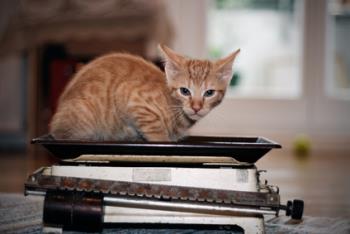
In previous articles, we talked a lot about obesity in cats. So far, we have covered the topics of top causes of obesity and why obesity is a bad thing for a cat.
How do you tell if your cat is fat? Does your cat need a veterinary examination to determine this? No, you can do so at home. In this article, you will learn how to tell if your cat is overweight or not.
1. Physical evaluation
The most convenient and reliable method of determining a cat’s body condition, no doubt, is a physical examination. As mentioned before, you can do this at home, by yourself, but you should not make any serious decisions based on your “in-home” findings. You can lower your cat’s food intake or increase his or her activity, but switching to a specific diet should be done only under veterinary guidance.
As of today, the easiest, most respected, and detailed method for evaluating your cat is the “S.H.A.P.E. Body Condition Guide” by WALTHAM Center for Pet Nutrition. Disclaimer: WALTHAM is associated with Mars, Inc., a company that produces several pet foods, such as Royal Canin, Whiskas, and Sheba. But they don’t try to disguise their ownership on their website.
We are always amazed about how people create acronyms of long, valid sentences and make them sound like a related word. S.H.A.P.E. stands for size, health, and physical evaluation; it also describes what you do: you physically examine your cat’s shape.
According to S.H.A.P.E., your cat’s weight is normal if you can feel his ribs with your fingers when you apply very light pressure, and there is no fat layer covering the ribs. Accordingly, if you need to apply great pressure to feel your cat’s ribs, or if you can’t feel the ribs at all, your cat is overweight or even obese.
Using S.H.A.P.E. is very easy. It’s a simple “YES or NO” test that begins by asking whether you can feel your cat’s ribs with your fingers without applying pressure. Then, depending on your answer, the test takes you to the next question. In the end, you will arrive at one of six scores ranging from “Extremely Thin” to “Severely Overweight.” You can find the S.H.A.P.E. method for cats here. If you have a dog, here’s a link to S.H.A.P.E. for dogs, too.
Other methods of body conditioning scoring exist. These methods usually offer detailed descriptions of the appearance of thin, normal, overweight, and obese cats. These methods also have you determine whether you can feel the ribs and whether the cat’s waist looks like an hourglass when viewed from the top or whether the abdomen curves inward or outward. There are many variations, and most are quite subjective, but they still give you a result. You can either do a Google search for Body Conditioning Scoring or find methods at most pet food manufacturer’s websites, such as Purina and Iams.
2. Compare your cat’s weight to the normal body weight of cats
If physical evaluations seem too mundane for you, you can always evaluate your cat’s body condition the same way most humans do for themselves: they weigh in. However, several factors influence the outcome and must be considered when assuming whether or not your cat is normal for his or her weight.
- Average cat. An average cat weighs 9 to 11 lbs (4 to 5 kg). But is there such a thing as an average cat?
- Body structure of cat. “I am not fat. I have big bones.” As with humans, cats have different body structures. Some cats are muscular, some are skinny. You can try to interpret whether your cat is larger or smaller than other cats in the neighborhood.
- Breed of the cat. Although there is not as large a variety of cat breeds as seen with dogs, cats also have some differences among breeds. For example, male Maine Coons usually average between 14 and 20 lbs (~6 to 9 kg). American and British short-hairs, Siamese, and Ragdolls tend to be slightly larger than the “average” cat.
- Gender of the cat. As with humans, female cats tend to be slightly lighter than males.
It is a good habit to monitor your cat’s weight regularly. Weigh your cat once or twice a month (preferably at the same time of the day), and record the result. By doing so, you will know if your cat suddenly begins to gain or lose weight even before visible changes occur.
How to weigh a cat
In case you were wondering, here is how to weigh a cat. You can use a simple human scale, weigh yourself with and without your cat in your hands, and then do the math. This way, you don’t have to force your cat to sit still on the scale until the results appear. Most cats will run away before that anyway.
3. Veterinary tests to assess the body condition of a cat
Ultrasound examination and blood testing are also available to determine your cat’s body fat index. Of course, these methods are usually used during the treatment of certain obesity-related diseases and are not practical merely to evaluate whether your cat is overweight.
So what did you find out about your cat? Do you think he or she could use some extra exercises or should be put on a diet?Check our other articles about stopping obesity in cats. In the next one, you are going to learn how to put your cat on a diet. Remember, though, that a veterinary examination and advice is always the best option.
